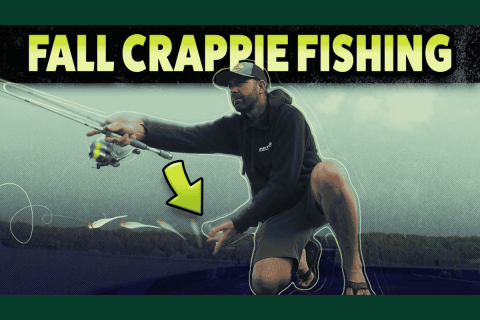
Fall Crappie Fishing with Casey Scanlon
Crisp mornings, changing leaves, and steady bites.
Fall is one of the most reliable and rewarding times to fish for crappie. Bass Pro Shops Pro Staff angler Casey Scanlon shares how to locate fall crappie, master dock-shooting techniques, and fine-tune your setup to catch more fish as temperatures drop.
Meet the Expert: Casey Scanlon
Casey Scanlon is a professional angler from Missouri and a full-time fishing guide on Lake of the Ozarks. Known for his consistency and skill at reading seasonal transitions, Casey teaches anglers how to find and catch crappie year-round using precision techniques that work in real-world conditions.
Understanding Fall Crappie Behavior
As the water cools and days get shorter, crappie begin feeding heavily to prepare for winter. They move toward structure that offers food and protection, such as boat docks, brush piles, and shaded cover. These areas often hold crappie stacked vertically in the water column, from just below the surface down to deeper brush.
“In the fall, crappie like to stack under docks and along shaded cover. Find one dock with bait and you’ll usually find a whole school,” Casey explains.
Casey’s Fall Crappie Setup
1) The Dock-Shooting Technique
Shooting jigs under docks is one of Casey’s go-to fall methods.
How to do it:
- Hold the jig between your thumb and forefinger.
- Load the rod tip like a bowstring and release to “shoot” the jig deep under the dock.
- Let the bait fall naturally while watching your high-visibility line for subtle bites.
This technique puts the bait where crappie hide and where most anglers cannot reach with a standard cast.
2) The Right Rod and Reel
Casey uses a Bass Pro Shops Pro Qualifier reel paired with a CarbonLite 2.0 rod for smooth shooting and quick hooksets.
- Line: 6 lb high-visibility Crappie Maxx monofilament.
- Why it matters: High-vis line helps detect light bites before you feel them and gives better control of the jig’s fall.
“Crappie are fast,” Casey says. “If you don’t see that line jump and set the hook right away, they’ll drop it.”
3) Jig Head and Soft Plastic Choices
Casey relies on Crappie Maxx jig heads (1/16-ounce) and the Bass Pro Shops Baby Shad soft plastics for their lifelike profile and action.
Top colors:
- Icicle: Clear water standard.
- Electric Chicken: Ideal for low-light conditions.
- Smokin’ Shad: Great all-around natural look.
Pair them with pink or chartreuse jig heads to increase visibility and contrast in different light and water conditions.
Fishing Tips for Fall Crappie
- Target docks on main lake points and channels where shad pass through.
- Look for shade and cover that hold heat and attract baitfish.
- Vary your jig depth to find suspended fish between 4 and 15 feet.
- Start with a slow retrieve and adjust speed based on fish activity.
- Keep multiple rods rigged with different colors to quickly adapt to changing light conditions.
Casey emphasizes that each cold front improves the bite. As the water continues to cool, crappie become even more aggressive and feed longer throughout the day.
The Surprise Factor
One reason Casey loves crappie fishing is its unpredictability.
“Every time I go out for crappie, I end up catching something unexpected,” he says. “Bass, catfish, even walleye. A small jig mimicking a shad can attract just about anything.”
This makes fall dock fishing both exciting and versatile for anglers of all skill levels.
- 171 views

